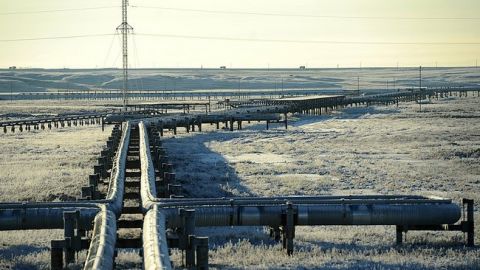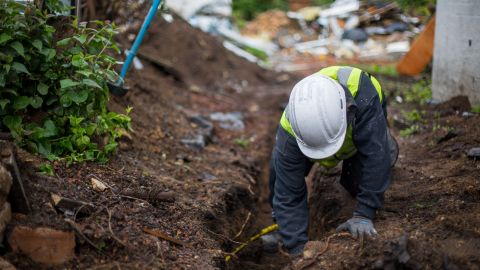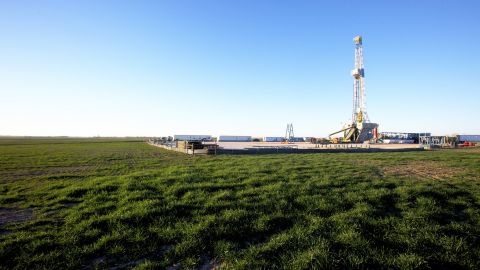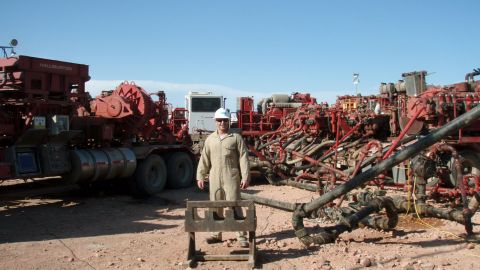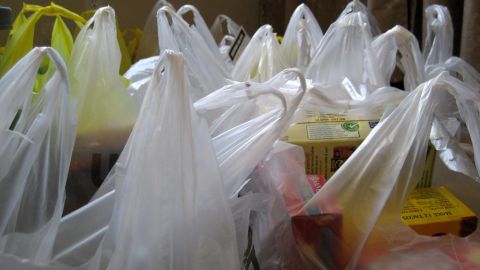AD READER: This episode of The Sweaty Penguin is brought to you by stationary bikes. Do you like pedaling but don’t want to go anywhere? Try stationary bikes today!
ETHAN: Happy New Year and welcome to episode 110 of The Sweaty Penguin: Antarctica’s Hottest Podcast. I’m your host, Ethan Brown. Today, we are talking about Canada: the only place where if you drive your car up onto the sidewalk and hit a bunch of people, they’ll apologize to you. Oh, sorry hun, didn’t mean to bump into your car there, eh. I’m a Canadian citizen, so I can make that joke.
ETHAN: But we’re not talking just about Canada. We’re talking about a natural gas reserve in Canada that is not only projected to release 13.7 billion tons of carbon dioxide into the atmosphere, but is also violating rights of Indigenous communities, exacerbating a host of health issues, and making everyone in the surrounding areas depressed? That’s right, even Canadians can get depressed, speaking as a half-Canadian myself. Although I wish I could blame my depression on fracking.
ETHAN: This gas reserve is in a region called the Montney Formation, and it is our seventh episode on a so-called carbon bomb. For those of you who are tuning in for the first time, here’s a quick rundown. And I’m gonna be really quick this time because, well, I have a doctor’s appointment. [deep breath] In a recent investigative report, [deep breath] The Guardian found that there are 195 oil and gas projects that have either started or been planned for the future that will emit over one billion tons of carbon dioxide in their lifetimes. Together, these 195 projects would emit a total of 646 billion tons of carbon dioxide, blowing past global climate goals. Phew! Ok, that might have been too fast. But if you want a better description here’s Maddy with the first hit single of 2023.
MADDY: Carbon bombs are gonna kill us all
Carbon bombs are gonna kill us all
Carbon bombs are gonna kill us all
Carbon bombs are gonna kill us all
In the Paris accords, a bunch of countries agreed
To keep global warming under 1.5 degrees (celsius)
This means reducing emissions 45% by 2030
But something’s throwing a wrench in these plans, and it’s dirty
The world releases 35 billion tons of carbon each year
But nearly 200 oil and gas projects should fill us all with fear
Carbon Bombs are gonna kill us all
Carbon Bombs destroy the earth for fun
Each project will release a billion tons at least
If you think that sounds wrong,
Then we gotta stop these carbon bombs
ETHAN: So does that mean I’ll be doing 195 carbon bomb episodes? Yup absolutely it does. And today, we are focusing on the 6th highest emitting project in the world at the Montney Formation. We’ll cover what issues are happening in this region, how they affect the lives of people there, and how the region moves forward which, spoiler alert, does not involve drilling for Tim Horton’s donuts. I wish, man. I wish.
ETHAN: The Sweaty Penguin is presented by Peril and Promise: a public media initiative from The WNET Group in New York, reporting on the issues and solutions around climate change. You can learn more at pbs.org/perilandpromise. If you want to take two minutes to help out The Sweaty Penguin, you can either leave us a five star rating and review or join our Patreon at patreon.com/thesweatypenguin. Doing that either earns you a special shoutout at the end of the show; joining the Patreon gets you merch, bonus content, and a whole lot more.
ETHAN: But first, it’s time for Montney 101. [bell ring] The Montney Formation is certifiably huge, covering around 130,000 square kilometers and stretching across the western Canadian provinces of British Columbia and Alberta. To put that into perspective, this formation is around the same size as Alabama or Greece! Also, Alabama and Greece are the same size? I didn’t think those two places were related in any way, but good to know my idea for an Alabaman-Greek Fusion restaurant isn’t totally off. Deep fried spanakopita anyone? And Canada doesn’t just get its money from maple syrup and Wayne Gretzky’s contracts — it’s also a major fossil fuel producer, and the Montney Formation comprises a third of Western Canada’s gas production.
ETHAN: The Montney Formation’s carbon bomb is estimated to release 13.7 billion tons of carbon dioxide throughout its life. But what makes Montney different from some other carbon bombs we’ve covered is that it’s mostly natural gas. Montney is one of the world’s largest unconventional gas plays, which is, coincidentally, exactly what they’re calling my one man show where I just fart out the entirety of The Crucible. What, it’s experimental!!! And just like me on opening night, Montney really does hold an incredible amount of gas, coming in at over 6 trillion cubic meters. Ironically, 6 trillion meters is also my listed height on Tinder. We’ll see fracking at lots of these places, but they’re fracking for different things. It’s not like the Bakken Formation we covered which is mostly oil or the Rovuma Basin we covered which is mostly natural gas liquids.
ETHAN: Montney’s siltstones have a very low permeability, which basically means the underground rock where the natural gas is doesn’t have a lot of holes. You know, like Wii Sports golf or literally any cheese besides Swiss. Because of that, it’s very difficult to get the natural gas to move up through the rock, so we need to use fracking to shoot fluid into the ground, create mini explosions inside the rock, and build up enough pressure that gas will flow up to ground level. But that process creates some problems. For one, because we have to shoot water mixed with sand and chemicals down well to create this pressure, fracking creates vast amounts of wastewater. It’s like when you leave the water running while you brush your teeth, but instead of water, it’s a fluid full of chemicals, and instead of having a drain, you have to find somewhere to put the chemical stew yourself, and instead of brushing your teeth, you’re digging a giant hole. So, really nothing like brushing your teeth actually. Disposal of that wastewater can often result in spills, injections into inadequate storage wells, or improper treatment, all of which can lead to the contamination of ground and surface water with endocrine disrupting chemicals which have shown to interfere with human hormone action, even in low concentrations, and impact developmental and reproductive health.
ETHAN: Fracking also releases a lot of methane — a greenhouse gas with 28 times the global warming impact of carbon dioxide. Now, we’ve talked about methane and fracking before, but in the case of a gas field like Montney, it’s a little different. In many cases, methane leaks come when you’re fracking for oil. If you’re fracking for oil but you’re not doing anything with the natural gas that comes up with it, you’re releasing a lot of methane because natural gas essentially is methane. It’s like methane, xanthan gum, and fox urine, I assume. But Montney’s different because here, we’re collecting the natural gas. And if we’re collecting it, why would methane be getting into the atmosphere? Well unfortunately, fracking for natural gas can have methane leakage rates as high as 7.9 percent. This may not sound like very much, but for a gas field with well over 6 trillion cubic meters of natural gas, we’re talking nearly half a trillion cubic meters getting leaked. That’s not just bad for the climate, but also a contributor to local air pollution and a complete waste of money for whoever is doing the fracking. Imagine if someone told you you were leaking money? Like the bank was just taking a percentage of the money in your bank account and making it go away? Can you imagine? … Wait… they do that? Overdraft fees? Oh, only for people who have a low account balance? Alright, that’s… great. Put simply, when methane leaks, everyone involved loses.
ETHAN: As fracking has taken off in the Montney area, they’ve also had an increase in seismic activity. From 2013 to 2019 alone, the region has seen a total of 439 earthquakes with close association to fracking activity. So how does this happen? Well, the high-pressure injection of fluid into the rock can cause the existing fractures in the rock to shift, leading to the release of seismic energy. As you may remember from your senior spring geology elective that you phoned in after realizing they wouldn’t talk about dinosaurs, faults are actually just fractures between two blocks of rock which allows them to move freely from each other. And movements in these slabs can cause earthquakes to be relatively large. Just last November, two significant back-to-back earthquakes with magnitudes of 4.6 and 4.7 struck in northern BC, which experts concluded were “very likely” caused by the ongoing fracking in the area. Now, a 4.6 or 4.7 earthquake doesn’t always cause damage — it’s more like the Earth just doing the Cha Cha Slide, but we are getting into worrisome territory there. Certainly we don’t want to induce earthquakes, especially given how little we know about them and how much damage they can cause if they get really bad.
ETHAN: So that’s a few ways fracking in the Montney Formation impacts the environment. How does it impact surrounding communities? Let’s bring in our expert Dr. Elyse Caron-Beaudoin, Assistant Pprofessor of Environmental Health at the University of Toronto, Scarborough. Dr. Caron-Beaudoin has studied the impacts of fracking on pregnant women in northeastern British Columbia in collaboration with healthcare providers and First Nations communities. I’ll let her explain in more detail.
- CARON-BEAUDOIN: So the first one in 2016, Was the pilot study, during which we recruited 29, pregnant women, living in this region. [00:02:47] We took some urine samples and hair samples, and we also had a questionnaire that the participants had to answer about, you know, life habits diet housing characteristics. The [00:03:02] type of water to consume and generate cetera. And then we, in this cohort, this very small cohort of pregnant women. We Measured levels of different contaminants. That might be associated with unconventional oil and gas development or, or [00:03:17] fracking. So that was the first pilot study. And then we used those results kind of, as a leverage to advocate for a larger biomonitoring study that is still ongoing called exposures in the Peace River, Valley or experimental [00:03:32] study.
ETHAN: And through these two studies — the pilot study she described and then the current study which had a similar design — she’s identified a very concerning issue.
- CARON-BEAUDOIN: So the first pilot study and then the experiment study, the only certainty that we have is that the levels of some pollutants that we investigated were [00:07:36] higher in our participants when we compared to reference populations or the general Canadian, or even American. Ian’s in our latest study experiment. We also found some correlations once [00:07:51] again between the levels of those contaminants and then metrics of density and proximity of oil and gas Wells.
ETHAN: And that’s not what you want to hear. Her team found high levels of some volatile organic compounds in tap water and indoor air in the homes of pregnant women living in the Peace River Valley in Northeast British Columbia, and the closer people lived to oil and gas wells, the higher concentrations of chemicals they found. These chemicals have been known to cause symptoms such as headaches, loss of coordination, and damage to the liver and kidneys.
ETHAN: Carbon bombs also affect mental health, and not just mine when I have to revise a script the day after my flight home and all I want is a nap. Dr. Caron-Beaudoin and her colleagues analyzed about 6,278 women who gave birth in Fort St. Johns hospital from 2006 to 2016, and their study shows definite associations between natural gas well density and increased diagnosis of depression around the Montney Formation. Which is really sad because you’re in Canada! You can have Coffee Crisps and poutine whenever you want! I know, I’m excessively a fan of all things Canada, but the point stands — increased depression is not good. They also found evidence of increased substance use during pregnancy for women in closer proximity to the well. But why is this? Are the gas wells emitting subconscious messages like “you suck, all your friends secretly hate you?” Not exactly. Pollutants can have an effect on mental health, but Dr. Caron-Beaudoin also points outs some other factors that play in.
- CARON-BEAUDOIN: Those measures having exposure can include, yes, some contaminants that are released during those operations but also a lot of non-chemical stressors. Is that come with oil and gas activity? We can think of noise the vibrations [00:10:21] during the fracking process, the traffic with the big trucks, hauling Water and Wastewater, and also just a community disturbances that it brings.
ETHAN: So it’s not just the contaminants, it’s also sheer annoyingness that is negatively impacting local residents. And we joke, but mental health issues are more than just the stuff of great comedians. No, stop joking about it! They’re bad. In addition to the substance abuse issue I mentioned, mental health issues can lead to unemployment, homelessness, suicide, or just impact quality of life. If gas exploration in the Montney formation is playing a role in that, it’s a serious cost to consider.
ETHAN: Now, I wouldn’t be doing my job as an interviewer if I didn’t get a little cynical with my guests. You know me, I’m famously a conspiracy theorist. Margot Robbie and Emma Mackey are obviously the same person. In this case, I was asking if the data Dr. Caron-Beaudoin and her colleagues put together can actually tell us definitively that fracking at Montney caused these adverse health effects. Here’s what she had to say.
- CARON-BEAUDOIN: The answer is unfortunately. No, we can’t. We cannot say at this point if our results are purely. You know, a result of correlation or if there’s really a cause to effect relationship [00:07:21] there in terms of our bio monitoring studies. […] Those contaminants, they can [00:08:21] have multiple sources of exposure ranging from putting gas in your car to having a fireplace at home to an attached garage. The type of paint that you store in your basement. That’s kind of stuff. So, we [00:08:36] correct for a lot of those other sources, but by the questionnaire that the participants have to answer, but it’s not perfect and we’re probably missing some of those Resources in the epidemiological studies [00:08:51] on birth outcomes and maternal mental health.
ETHAN: What does that mean? It means despite all her findings, we can’t technically say that fracking in the Montney Formation is causing all these issues. All we can say is in the region, there’s a correlation between fracking and insert health issue here. That’s not to say fracking isn’t causing it — I think we can agree it would be surprising if that wasn’t the cause given the information we have — but scientists have to keep working to actually demonstrate it. Because there are a lot of bizarre correlations out there that have no causal relationship. For example, per capita consumption of mozzarella cheese and civil engineering doctorates awarded were correlated from 2000 to 2009. People who drowned after falling out of a fishing boat and marriage rate in Kentucky were correlated from 1999 to 2010. And my personal favorite: the number of letters in the winning word at the Scripps National Spelling Bee and number of people killed by venomous spiders each year were correlated from 1999 to 2009. Obviously none of these things cause the other, although I would consider making the winning word at the spelling bee “it” from now on to see if it reduces spider deaths, but that goes to show why even though there are demonstrated health effects, we still have to keep researching. We can hypothesize that fracking is causing these problems and I think that’s reasonable, but we also have to acknowledge the status of current research in the region.
ETHAN: And it’s not just environmental and health impacts either — this fracking also takes place on Indigenous land. In 1899, the First Nations of Northern Alberta, Northwestern Saskatchewan, the Northwest Territories, and the Northeastern portion of British Columbia, signed Treaty 8 with the Queen of England that promised that nothing would be done or allowed to interfere with their way of living. Treaty 8 covers a land mass of approximately 840,000 kilometers, and is home to 39 First Nation communities. Why it took 8 treaties to get there, I don’t know. I mean, what was Treaty 1? Whoever calls dibs first gets the land? At any rate, First Nations communities use their land for hunting, fishing, and gathering, and that depends on the viability of the surrounding ecosystems. Because the land is so heavily impacted by industrial development, Treaty 8 is not being upheld and traditional ways of life for these communities are at risk. From 2002 to 2012 alone, 59,915 km of disturbance were created in Fort Nelson First Nations territory by roads, pipelines, and seismic lines.
ETHAN: And that brings us to one of the big controversies in the region: the Coastal Gaslink Pipeline. This pipeline project was proposed in 2012, and plans to transport gas 670 kilometers to the West Coast of British Columbia. The pipeline will pass through the lands of the Wet’suwet’en Nation, but traditional chiefs of the nation never agreed to the pipeline project. Listen to ‘Sleydo’ Molly Wickham describe some of what’s currently going on in the Wet’suwet’en territory.
CLIP This is Sleydo. I’m here in Gidmit’en territory of the Wet’suwet’en nation, where we are resisting a fracked gas pipeline. This project would be a first of many that would pass through our territories bringing fracked gas to the coast. Bringing oil to the coast from the Tar Sands, which would devastate the coastal communities, and our ability to pass on our culture and live as indigenous people on our lands.
ETHAN: Adding civil unrest to the problems caused by the Montney Formation, it’s clear this carbon bomb threatens more than just the climate. The Nation is stating the pipeline has violated the United Nations Declaration on the Rights of Indigenous Peoples by being allowed to continue without their consent. Since November 2018 when the Canadian government sent an injunction to a Unist’ot’en camp that was blocking the production of the pipeline, people have taken to the streets with protests and blockade, even blocking access to road shipping ports and commuter rail lines. Many protesters over the past years have been arrested and charged, and despite continued efforts to stop the pipeline, construction on the Coastal Gaslink continues, and is currently 70 percent complete. And again, this isn’t just about a treaty from 1899, although that’s part of it. It’s about people like Sleydo who want to live their life and pass on their culture, and due to this gas exploration, all of that is disrupted.
ETHAN: So all of this — environmental impacts, health impacts, local dissatisfaction — have an impact on the economy, be it lower productivity or increased health costs or you name it. It’s tricky, though, when you’re trying to square that with the benefits of creating jobs and providing energy. Here’s what I’ll say: it’s not necessarily clear-cut what the economic realities of the Montney Formation are the way it might have been for some other carbon bombs we’ve covered. But we do know this: building pipelines, building LNG terminals, all of this is a long, challenging, and expensive endeavor. If you thought building a Jenga tower was annoying, this is like… a whole new level of construction. And natural gas prices, to their credit, are very low. Which is surprising because everything labeled “natural” at Whole Foods is so much more expensive! Those low energy prices are good for consumers, but if you’re building out all this infrastructure, you need to make the money back. Seeing those low prices today and knowing how rapidly the energy market is transitioning away from fossil fuels, you have to wonder if this natural gas exploration would end up turning a profit. In a lot of historic cases, we’ve seen fracking get a lot of people excited and then lead to bankruptcies, lost jobs, and disappointed investors, and if money does come in in the best case scenario, rarely do local communities see any benefit from it.
ETHAN: So is Canada over? Will we have to turn in all our maple syrup for Mrs. Butterworths now? Of course not. After the break, we’ll explore what the future could look like for the Montney Formation. How can we maintain economic excitement while protecting the environment, health, and livelihoods of local communities all at the same time?
AD READER: Do you like to bike, but hate that pesky changing scenery? Then stationary bikes are for you. With stationary bikes, you can get the workout you need without all that awful human interaction. Our video classes will have you sweating and gasping for air all while going absolutely nowhere. The coaches will call out instructions and you don’t have to verbally respond, just pedal! What’s more? If you don’t pay extra for the exercise video subscription, the bike will be completely useless! Stationary bikes: the most expensive coat rack you will ever buy.
ETHAN: The Sweaty Penguin is presented by Peril and Promise: a public media initiative from The WNET Group in New York, reporting on the issues and solutions around climate change. You can learn more at pbs.org/perilandpromise.
ETHAN: So how do we forge a better path forward in the Montney region? To start, it would help to have a better understanding of some of the problems. We can make a lot of inferences off Dr. Caron-Beaudoin’s data or knowledge at other fracking sites, but the fact is this region is really understudied. Dr. Caron-Beaudoin, for example, says her next project is going to investigate food contamination.
- CARON-BEAUDOIN: We’re actually right in the middle of writing a Grant application with the same local partners and one of [00:20:38] the main concerns that they have is to ensure that the Industrial Development in their region which includes oil and gas activity. Is not impacting traditional food quality. [00:20:53] So we hope to track environmental contamination of traditional food items over a long period of time while building local research capacity as well.
ETHAN: That said, we know enough to start taking action. Whatever the cause may be, there are physical and mental health issues at higher rates in this region. So in addition to further studying the region, working on ways to improve mental and physical health in these communities could be a good priority. What that looks like is a little above my paygrade as a climate person who lives in an entirely different country, although if you want a little fun fact, there’s a part of Canada called Middle Island which is so far south that it’s actually south of a small sliver of Northern California. What I’m saying is there are people in my state who live north of Canada and for that reason, I basically live in the Montney region too. Right? Any objections?
ETHAN: On the environmental side though, there’s a lot that can be done to make the process cleaner. Of course it’s never going to be perfect, it’s like trying to wipe vomit with those brown paper towels from elementary school, but that’s not to say there can’t be improvements. Companies can consider using waterless fracking systems, using recycled water, or purifying wastewater. They could replace diesel powered equipment with equipment that’s powered by cleaner energy sources, and now might be a good time given the high prices of diesel. And there are even ways to reduce methane leaks. Companies can detect leaks with infrared cameras or replace equipment with lower bleed designs, ensuring less gas escapes. I’d also consider adding some Mylanta to the fracking fluid. I mean, if it worked on me when I had QDoba right before boarding my flight, you’d think it would ensure less gas leaks at a well, right?
ETHAN: What about reducing the seismic activity? One way to help reduce the chance of random earthquakes is further mapping the region for natural faults in the rock. We gotta know which rock has a pimple, which rock has green texts, which rock rooted for France in the World Cup final… you know, find their faults. This wouldn’t put an end to earthquakes in the area, but it could help with the siting of wells, or if a well is on a fault, seismic activity would be a little more predictable and communities could be more ready if a serious event were to occur.
ETHAN: All that said, while these solutions would help local communities, they don’t really address one of the key issues, that being climate change. Keep in mind, climate change is a concern in this region too. In the First Nation community of Fort Nelson, for example, they’re experiencing a shift from a more subarctic climate to a more humid continental climate. They’re seeing more swamps which encroach on caribou habitats and lead to more bugs which infect moose and contaminate their meat. Cause that’s exactly what a region dealing with a billion other nuisances needs: bugs! Now there’s an offer you can’t refuse! Eastern British Columbia also has wildfires which are worsening. Plus, there is permafrost in parts of the Montney which is melting and releasing even more carbon into the atmosphere. All that and more suggests climate change, too, is affecting the livelihoods of people in this region, and as home to the sixth highest emitting fossil fuel project on the planet, the Montney Formation certainly ties right into that conversation.
ETHAN: So if we want to phase down gas production in the region for all these reasons, what other industries could provide energy and economic opportunity? One exciting option is hydroelectric power. And I’ll tell you, that might be the best… dam idea I’ve ever heard. [booo] Come on, all I’m saying is it ought to be in the mainstream. [booo] What, it would go swimmingly! [keep the boos going, have it like interrupting me by the end] Okay, fine… It’s true though. British Columbia is full of rivers and water bodies. In fact, in British Columbia, about 87% of electricity already is produced from hydroelectric sources, and BC Hydro has invested over $260 million through programs and incentives over the next 5 years to boost the hydropower industry. So clearly people are excited about hydro, but it’s not just because it’s carbon-free and renewable energy. The construction and operation of dams can also create jobs further stimulating economic growth in the area. So in that way, it doesn’t have to be some environment versus economy tradeoff. Now, even with it being carbon-free, there are some concerns about the environmental impact of hydro dams, like their potential to disrupt fish populations, but certainly it’s possible to address those issues if hydroelectric power continues to expand. I mean, you know how much I love the salmon canon.
ETHAN: Another option here is geothermal. Geothermal energy is a type of renewable energy that comes from the Earth’s internal heat, which is produced by the natural decay of radioactive elements, the molten core of the Earth, and the hot apple cider it drank this morning. Sounds scary, but it’s actually a potentially great source! According to a study by the Canadian National Geothermal Database, British Columbia has enormous potential to produce geothermal power. And that’s exciting because geothermal energy is only available in certain locations, often near faults and tectonic plate boundaries. As it stands right now, geothermal is still expensive and has an upfront cost, so I wouldn’t call it a silver bullet solution, but certainly BC could consider if they want to be a leader and innovator in this industry, create jobs, and try to grow the economy that way.
ETHAN: So there’s a lot of options for how to move forward. Ultimately, though, as we always say, the best path forward is what that local community wants knowing all of this information. That may be even more so the case with Montney where there’s literally a treaty saying not to disrupt the lands and livelihoods of the First Nations communities there. Knowing that, if their perspective isn’t being valued, First Nations communities actually have some legal options they can explore.
ETHAN: Take the Blueberry River First Nations. First of all, I just have to address what is maybe the coolest name for a community I’ve ever heard. You can’t convince me there’s not an actual river with blueberries there. I refuse to believe otherwise. Since 2012, the oil & gas industry has been progressively encroaching on their land, developing wells, pipelines and roads. By 2018, 85% of Blueberry River land was within 250 meters of an industrial disturbance. That’s a lot of production for one area, and it resulted in diminished land for hunting, fishing, and camping, impacts for wildlife in the area, and even the destruction of berry picking sites by pathways and pipelines. The Nation filed the claim against the government in 2015, and in 2021, the Supreme Court of British Columbia ruled in The Blueberry River First Nations’ favor, agreeing that developments authorized by the Province have significantly diminished the ability of this community to live their traditional way of life. This ruling ended up being the first of its kind in Canada and shows the value in allowing communities to have a loud voice. My only issue is did it really have to take six years to get a ruling on this? Seriously, that’s even longer than the wait between seasons of Better Call Saul. Nothing should take that long!
ETHAN: To get to this point, though, communities need to be armed with information, and that’s where Dr. Caron-Beaudoin says more work may need to be done.
- CARON-BEAUDOIN: In Canada, and similarly in the US and also other nations, local people, and First Nations governments are involved in different phases [00:18:23] of, you know, permitting the cleanup process of oil and gas, infrastructures through consultation processes yet. In the case of Canada’s consultation policy for indigenous peoples, it’s unclear [00:18:38] whether First Nations governments are in a position to have a Access to the best information possible about health risks and environmental impacts in part, given the lack of research in that area.
ETHAN: First Nations governments are involved in different phases of decision-making around oil and gas development, but without concrete evidence of negative impacts, it’s a lot harder to argue your case. Dr. Caron-Beaudoin’s research can help with this. But it’s challenging too, because this research takes a lot of time and effort.
- CARON-BEAUDOIN: What is really? I think lacking in the scientific literature. Well in Canada. Pretty much everything [00:15:08] but more specifically. Overall I think it are bio monitoring studies. So to the best of my knowledge, the last time I checked our studies, our bio monitoring studies or still, the only one published in the literature. […] I mean those bio monitoring studies. Take a lot of time. There’s a lot of logistical [00:16:08] challenges associated with the recruitment of participants especially in rural areas where obviously don’t have your lab facilities close, you need to ship samples across large distances and be samples [00:16:23] are sensitive to temperature change for example. So there’s just a lot of Logistical challenges Associated, and it’s also very expensive to conduct biomonitoring studies.
ETHAN: But despite these challenges, researchers like her have obviously pressed forward, finding that gathering this information and providing it to communities is essential to their efforts in improving their health, environment, economy, and livelihoods.
ETHAN: As always with carbon bombs, there’s no clear perfect answer for what to do. But there are so many options for how this major project can reduce its impact or phase down and give way to other industries that bring about many of the same benefits without the slew of costs. These issues are never easy, but if we can continue learning about the Montney Formation and find a better path forward, we’ll help the climate, improve human health, protect the rights of First Nation communities, and ensure the only unconventional gas play is my farting of The Crucible.
ETHAN: This wraps up episode 110 of The Sweaty Penguin. Take two minutes, help out the show, and get a shoutout at the end of the show by leaving a five star rating and a review on Apple or Podcast Addict OR join our Patreon at patreon.com/thesweatypenguin. You get merch, bonus content, and more.
ETHAN: Clips today came from Stand Earth. Special thanks to our Emperor Penguin patrons Lawrence Harris and Brownies Central. The Sweaty Penguin is presented by Peril and Promise: a public media initiative from The WNET Group in New York, reporting on the issues and solutions around climate change. You can learn more at pbs.org/perilandpromise. The opinions expressed in this podcast are those of the host and guests. They do not necessarily reflect the opinions or views of Peril and Promise or The WNET Group. Thank you all for listening, and I’ll see you next week.

